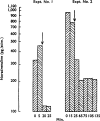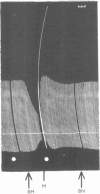The actions of bretylium: adrenergic neurone blocking and other effects. 1959
- PMID: 9142404
- PMCID: PMC3224290
- DOI: 10.1111/j.1476-5381.1997.tb06795.x
The actions of bretylium: adrenergic neurone blocking and other effects. 1959
Abstract
Bretylium caused a specific and lasting depression of many excitatory and inhibitory responses evoked by electrical stimulation of the peripheral sympathetic nervous system, probably by impairing conduction of impulses in adrenergic neurones with consequent failure of noradrenaline and adrenaline release. This effect, which will be referred to as the adrenergic neurone blocking action, was preceded by weak sympathomimetic effects. In the presence of bretylium the effects of adrenaline and noradrenaline were increased, as after sympathectomy. Concentrations producing blocking of adrenergic neurones did not prevent the release of adrenaline and noradrenaline from the adrenal medulla by splanchnic nerve stimulation or by the injection of dimethylphenylpiperazinium iodide, nor did they cause antiparasympathetic or parasympathomimetic effects. No action on the central nervous system has been detected. Curare-like neuromuscular block occurred with 10 to 30 times the amount required to block the response to adrenergic nerve stimulation alone and was accompanied by signs of temporary synaptic block in autonomic ganglia. A drenergic. nerve trunks and sensory nerves in the skin were readily blocked for long periods by topical application of bretylium, whereas the phrenic nerve of the rat was not. Bretylium had little effect on gastrointestinal propulsion or on the sensitivity of smooth muscle to acetylcholine, 5-hydroxytryptamine, adrenaline, or noradrenaline, but moderate amounts depressed the peristaltic reflex and the sensitivity of the guinea-pig ileum to histamine. Bretylium caused postural hypotension in the cat in doses which had little effect on the supine blood pressure. Experiments on the nictitating membrane indicated that compensation for the effects of bretylium on low rates of stimulation of postganglionic sympathetic nerves could be attained by a small increase in the rate of stimulation, whereas compensation for its effects on high rates required an increase in the rate of stimulation beyond physiological limits.
Figures














Similar articles
-
Synthesis and adrenergic neuron blocking properties of some alkylating analogues of bretylium.Arch Int Pharmacodyn Ther. 1975 Nov;218(1):96-105. Arch Int Pharmacodyn Ther. 1975. PMID: 1212016
-
The actions of bretylium: adrenergic neurone blocking and other effects.Br J Pharmacol Chemother. 1959 Dec;14(4):536-48. doi: 10.1111/j.1476-5381.1959.tb00961.x. Br J Pharmacol Chemother. 1959. PMID: 13803290 Free PMC article.
-
Some factors affecting the neuron blocking action of guanethidine, xylocholine, bretylium and debrisoquin.Jpn J Pharmacol. 1973 Dec;23(6):805-11. doi: 10.1254/jjp.23.805. Jpn J Pharmacol. 1973. PMID: 4544694 No abstract available.
-
Pharmacological actions of aminopyridines and related compounds.Rev Pure Appl Pharmacol Sci. 1981 Oct-Dec;2(4):317-71. Rev Pure Appl Pharmacol Sci. 1981. PMID: 6278543 Review. No abstract available.
-
[Drugs with effect on the adrenergic nerve fiber].Pharm Acta Helv. 1968 Dec;43(12):757-75. Pharm Acta Helv. 1968. PMID: 4886667 Review. German. No abstract available.
Cited by
-
Bretylium abolishes neurotransmitter release without necessarily abolishing the nerve terminal action potential in sympathetic terminals.Br J Pharmacol. 2008 Feb;153(4):831-9. doi: 10.1038/sj.bjp.0707623. Epub 2007 Dec 10. Br J Pharmacol. 2008. PMID: 18071295 Free PMC article.
-
Acute cold exposure induces vagally mediated Fos expression in gastric myenteric neurons in conscious rats.Am J Physiol Gastrointest Liver Physiol. 2001 Aug;281(2):G560-8. doi: 10.1152/ajpgi.2001.281.2.G560. Am J Physiol Gastrointest Liver Physiol. 2001. PMID: 11447037 Free PMC article.
References
Publication types
MeSH terms
Substances
Personal name as subject
- Actions
- Actions
LinkOut - more resources
Full Text Sources
Miscellaneous

